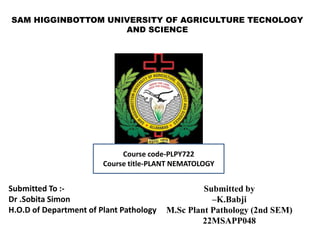
k.Babji 22MSAPP048(722).pptx
- 1. SAM HIGGINBOTTOM UNIVERSITY OF AGRICULTURE TECNOLOGY AND SCIENCE Submitted To :- Dr .Sobita Simon H.O.D of Department of Plant Pathology Submitted by –K.Babji M.Sc Plant Pathology (2nd SEM) 22MSAPP048 Course code-PLPY722 Course title-PLANT NEMATOLOGY
- 2. Migratory Endoparasitic Nematode • Ditylinchus dispsaci
- 3. INTRODUCTION Ditylenchus dipsaci is an internal parasite of bulbs, stems, and leaves and passes generation after generation in these tissues, escaping to the soil only when living conditions in the plant tissues become unfavorable.
- 4. Scientific classification Phylum – Nematoda Class – Secernentea Order – Tylenchida Suborder – Tylenchina Superfamily – Anguinoidea Family – Anguinidae Genus – Ditylenchus Species – Ditylenchus dipsaci
- 5. Discovery • Ditylenchus dipsci was first discovered by the German botanist Julius Kuhn in 1857.Kuhn found this nematode infesting Onion bulbs in German. Initial classification Kuhn initially classified the nematode as tylenchus dipsaci, based on its morphological characteristics and its association with the host plant, onion Reclassification of ditylenchus dipsaci Over time, further studies on the nematodes characteristics , life cycle, and taxonomy led to its reclassification as Ditylenchus dipsaci
- 6. Importance • D. dipsaci shows parasitic adaptation in its ability to invade solid parenchyma tissue following enzymatic lysis of the pectic or middle lamella layer between adjacent cell walls, leading to separation and rounding of the cells. This causes the typical glistening appearance or mealy texture of infested tissues, reminiscent of the flesh of an over-ripe apple (Southey, 1993).
- 7. Host range D. dipsaci has an extensive host range. Major damage occurs in garlic, onion, carrot, fava bean, alfalfa, oats, and strawberry. Ornamental plants can also be infected including hyacinth and tulip.[12] It is estimated that this pathogen infects 400–500 plant species worldwide. In Allium species (onions, garlic, and leeks), infected plants show characteristic symptoms including stunted growth, yellow spots, leaf curl, and foliage lesions. Stems often have swollen regions called “spikkles.” As adult nematodes migrate into the scales of the bulb, and the scales become soft, grey, and loosely packed. Highly infected bulbs can also split apart or show malformed bloating. The leaves of the plant become flaccid and may collapse. This can lead to defoliated plants.Garlic shows similar symptoms of leaf yellowing and stunted bulbs. When harvested, the infected garlic may be missing portions of the root system. Symptoms
- 8. Survival absence of host • The lifespan of stem and bulb nematodes is about 70 days. Most generations are passed inside bulbs, stems and leaves. Eggs and larvae overwinter in dried infected host material.They are also found in weed hosts and seeds of composite. Stem and bulb nematodes can survive up to two years in freezing or extremely dry environments in the soil. D. dipsaci can survive on or in plant tissue by entering cryptobiosis and survive for 3–5 years in this stage. During dormancy, D. dipsaci shows no sign of life and the metabolic activity is almost at a standstill.
- 9. Life cycle • Stem and bulb nematodes are migratory endoparasites. Their life cycle occurs in five stages with the first molt occurring in the egg and the second and third molt occurring in the soil. By the fourth stage juveniles have entered the plant through young tissue and/or seedlings. The fourth molt will then occur inside the plant. The adult female must mate with a male to reproduce and lay eggs. A complete reproductive life cycle of the stem and bulb nematode is 19-25 days (egg to egg). Reproduction takes place in succulent, rapidly growing tissues or in storage organs and continues throughout. A female can lay 200-500 eggs in her lifespan. However if conditions are unfavorable the nematodes can halt their life cycle. The life span of stem and bulb nematodes is approximately 70 days. Most generations are passed inside bulbs, stems and leaves. Eggs and larvae overwinter in dried infected host material. They are also found in weed hosts and seeds of composite. Stem and bulb nematode can survive up to two years in freezing or extremely dry environments in the soil. D. Dipsaci can survive on or in plant tissue by entering cryptobiosis (hidden life) and survive for 3-5 years in this stage. During dormancy D. Dipsaci shows no sign of life and the metabolic activity is almost at a standstill.
- 11. Management • Proper sanitation in fields and of tools is essential in preventing and controlling the spread of D. dipsaci, because they can survive and reproduce in infected plants and residues. The fourth-stage juvenile is the most resilient and can survive repeated desiccation or drying and recover upon rehydration. All infected tissues should be removed from growing sites and destroyed to control populations, and all farm tools and equipment should be cleaned of potentially contaminated soil before moving them to a new location. • The time a susceptible host crop is planted also infects the severity of nematode damage. Cooler temperatures and lower humidity can suppress the reproduction and infestation rates of D. dipsaci. Growers should avoid planting susceptible bulbs, seeds, or seedling during seasons of peak nematode infection. Soil fumigation in fields during fall can control nematodes on a susceptible crop in the spring. A nematicide fumigant that is specific to the genus Ditylenchus should be used. Selectively fumigate only the regions of the fields that are infected to ensure that the high cost of fumigating does not mitigate the economic gain from saving crops from nematode damage. Fumigants are usually applied before planting and subsequently after emergence.
- 12. THANK YOU